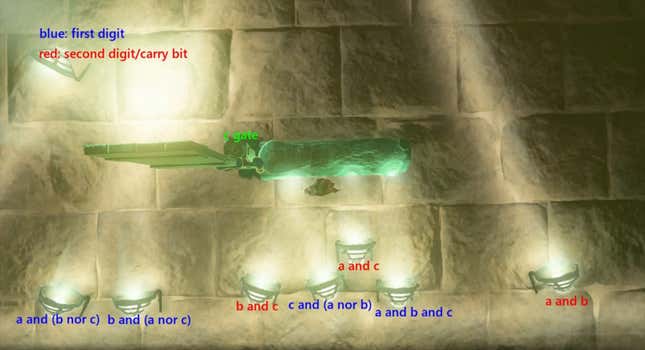I mean, it was only a matter of time, right? Nintendo’s hit open-world game Tears of the Kingdom features a surprisingly robust and dynamic physics system you can build with, so it stands to reason that if you create a few “if this then that” scenarios, then bam, you basically have the working fundamentals of a computer system. And that’s exactly what players are doing now. Go ahead and get the “can it run Doom?” joke out of your system. I’ll wait.
Tears of the Kingdom doesn’t just repeat the same expansive open world formula of its predecessor, Breath of the Wild. With the ability to manipulate various objects, glue them together, and have them interact with a remarkably fluid and realistic physics simulation, players have found interesting ways to traverse the map, build incredible death contraptions, or do silly things like build a pilotable T-rex or, um, Metal Gear Ray. But now, Hyrulian engineers are turning their attention to programming logic, using the game’s building systems to now make more complex contraptions and even rudimentary computational processes. Think of it as Zelda’s version of redstone from Minecraft. And it’s working.
Tears of the Kingdom player builds a basic calculator in the game
The first example of such a device is this one-bit calculator built with rotating panels and lights.
Now it may not be entirely obvious what’s going on here, so let’s try to break this down. As software developer Zenni told Kotaku, calculators are essentially “made out of inputs of 1 or 0 and go through logic gates which can determine an output.” She continues:
Instead of gates, [this example uses] mirrors to act as logic gates and a physical gate to determine which inputs to switch between. The example [in the original video] is 1 bit, so adding 1 + 0 which equals 1, or 1 + 1 = 0 with a carry of 1. If you could bypass the drop limit of TotK, you could actually make a working calculator, which is really cool.
As some in the comments of the original video have stated, this is an “Adder,” which, as you might’ve guessed, adds things together. It’s the most fundamental function of how a computer works.

Here’s a more basic example illustrating how rotating devices and light objects can be used to create scenarios that control different inputs and outputs:
After building this, user c7fab was able to make a slightly less advanced version of the video above with a half adder:
Now before you go any further in referencing that darn ‘90s shooter everyone seems bent to get running on just about everything, there is a limit as to how complex this is thanks to Tears of the Kingdom’s 21-object build limit. In theory, if you took multiples of these Hyrulian adders and had them function in concert, you could get more complex computations, leading all the way up to what we’d expect from a fully functioning calculator. But given the game’s limit, it’s unlikely that we’ll see anything beyond simple base two computations.
Inspired by the ways other gamers have built computers within games, such as Minecraft or Mario Maker, c7fab tells Kotaku that it took him three hours to come up with the final design
“At first, making a full adder seemed out of scope, because the half adder I built took too many glued parts, but then I realized I could use the diagonals too, making a full adder possible,” he added.
As you might expect, some troubleshooting was involved, and the game’s generous-but-limited item count soon became a bit of a pain. “I had an initial design with less glued parts and more free-standing mirrors, but it was not possible to set it up since the constant need to readjust and the mirrors then would just disappear after some time,” he said.
C7fab said that since there aren’t any Zonai devices that can take light as an input, a one-bit full adder is probably the limit. “Other players have built logic gates using electricity,” he said “but that took way too many glued parts and they could only build a half-adder.”
As far as future improvements and implementations, c7fab isn’t sure much is possible beyond what’s already been done. “I don’t see any useful builds you could make with using light for logic gates unless a DLC gives us input devices that act on light.”
Other feats of Hyrulian engineering
But, basic calculators ain’t all. As you may well know, Tears of the Kingdom also features physics by way of electricity. That means that creating circuits isn’t just limited to lights and mirrors. Check out this video showing off how with a bit of electricity and moving objects, you can have some interesting interactions.
Another example is a functioning diode, which allows electricity to flow in a specific direction, built using various Zonai devices.
Here’s another feat of engineering from user lyouke on Reddit, this time a transistor that doesn’t need Zonai power to function (Tears of the Kingdom uses two types of power, electricity and mystical Zonai power).
While these examples are very basic compared to what kinds of devices and computational processes we use every day, it’s kind of stunning that this at all works and, when you get right down to it, how simple many modern day feats of technology are at their core.
Update 6/14/23, 4:45 ET: This story has been updated to include statements from the designer of the light-based Zonai adder.